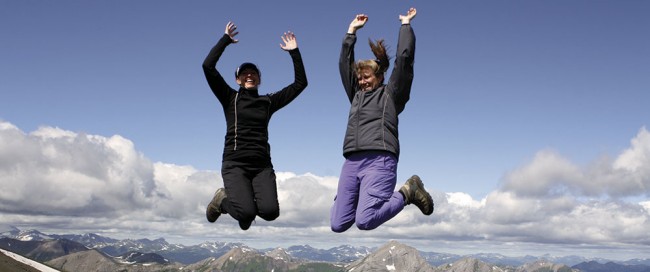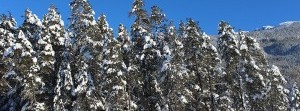
Photo Credit: Kevin Sharman
Tumbler Ridge wins Global Geopark status. What’s next for northern BC’s geological mecca?
Folks in Tumbler Ridge aren’t strangers to uncertainty.
Perhaps that’s why a delegation at the sixth International UNESCO Conference on Global Geoparks in Saint John, NB wasn’t going to celebrate until they heard the name they were waiting for: Tumbler Ridge Global Geopark.
After five days spent at the conference and many months wooing the committee to grant the region geopark status, it came at the final evening’s banquet, at the end of a list of 11 new geoparks worldwide: a little joke played by the National Geopark Committee on the host nation’s newest globally designated geological attraction.
“It was quite tense,” remembers Charles Helm, a Tumbler Ridge physician and one of seven delegates from northeastern BC who attended the conference. “Everything boiled down to the last moment.”
A volunteer group pulled together an application for the 7,722-square-kilometre geopark in a matter of months, submitting it to the Global Geopark Network upon recommendation by a visiting Canadian National Committee for Geoparks. An international delegation visited Tumbler Ridge in June, announcing their decision at September’s conference.
“It was by no means guaranteed. We were optimistic, but not unreasonably so,” Helm says.
According to UNESCO’s website, at the start of 2014 there were 100 Global Geoparks in 30 countries. While geoparks were traditionally concentrated in Europe and China, they now span all continents. Tumbler Ridge’s designation is Canada’s second, after Stonehammer Geopark in New Brunswick.
Struggle not over
Tumbler Ridge was incorporated in 1981 to house employees of local coalmines and, more than 30 years later, the town has seen its share of ups and downs.
While its recent designation and increasing recognition as a tourism destination bode well for the community’s future, Tumbler Ridge was recently shaken by the news of more economic challenges ahead. Of the community’s existing coalmines, one is currently idling (with no current plans to reopen), another plans to shut indefinitely in December and plans were cancelled to open a third.
But along with uncertainty, Tumbler Ridge is also familiar with resilience.
During a 2001 economic downturn, Helm’s son Daniel, then eight years old, discovered dinosaur footprints while river tubing with a friend. That discovery led to others and, in 2003, paleontologist couple Rich McCrea and Lisa Buckley started the Peace Region Palaeontology Research Centre and later the Dinosaur Discovery Gallery, which sees thousands of visitors each year with numbers increasing 10 to 15 percent annually.
Along with its prehistoric resources, the community is famous for sitting within hiking, driving or boating distance of 36 waterfalls and boasts more than 100 kilometres of hiking and biking trails. In winter, there is cross-country skiing, ice climbing and snowmobiling. It’s hoped that the recent designation will raise awareness for these attractions.
At a geopark in Greece, the designation caused the region’s tourism to grow from 5,000 to 100,000 annual visitors in a decade, Helm says. Although a similar effect would be welcomed in the Northeast, it’s unlikely to happen overnight. While Global Geopark designation is encouraging, the hard work is still ahead.
Growing into geopark
The job of bringing increased tourism to the region now falls mostly to local entrepreneurs, Helm says, and the next step is educating the business community on local geology and what it means to be a Global Geopark. That is currently starting with an education strategy and securing funding for a full-time education coordinator.
“It’s not immediate. It still takes time to do the work and get the benefits,” Helm says. He encourages local businesses to jump on board the geology theme. For his part, the local physician takes photos of newborn babies with a dinosaur bone in their hand—hokey, he admits, but he hopes it will inspire others to find ways to incorporate the theme into their businesses.
“The brand is there,” he says. “People have to have the entrepreneurial spirit and say, well, I would like to do this.”
The Gulicks have been involved with the local business community since moving to Tumbler Ridge several years ago. Randy, who has been a riverboat operator on and off for nearly two decades, learned about local rock formations when he brought a geologist on a search for features in preparation for the geopark application; he also toured the UNESCO committee that evaluated the region’s geopark status.
“I hope it brings an influx of tourism,” says Randy, who has visited the area since he was a kid and married his wife, Roxanne, at Kinuseo Falls on the Murray River in 2001.
“It’s fun taking people who are excited about seeing new things,” he says. “You get to see the look on other people’s faces when they see it for the first time.”
Roxanne Gulick, president of the Tumbler Ridge Chamber of Commerce, says education is the next step for local business owners.
“I think there will definitely be people who step up to the plate and take advantage of the tourism aspect,” she says. “There’s still lots of possibilities. Tumbler Ridge has gone through this before and found ways to succeed.
“This can only be a good thing for us. One of two geoparks in North America—that can only be a jump in the right direction.”
A new visitor information centre opens this fall, where, it can be assumed, the new Global Geopark status will be heavily marketed. Additionally, the town has three wind tower projects on the horizon along with potential LNG development that could help to diversify its economy.
But if there’s one thing that can be said for certain about Tumbler Ridge, it’s that it doesn’t lack for interest. New geological discoveries are happening all the time, creating new opportunities as quickly as existing ones falter. It’s a community that has, thus far, successfully surfed the waves of economic boom-and-bust and stood strong in the winds of change.
:
For more information, visit http://trgg.ca









